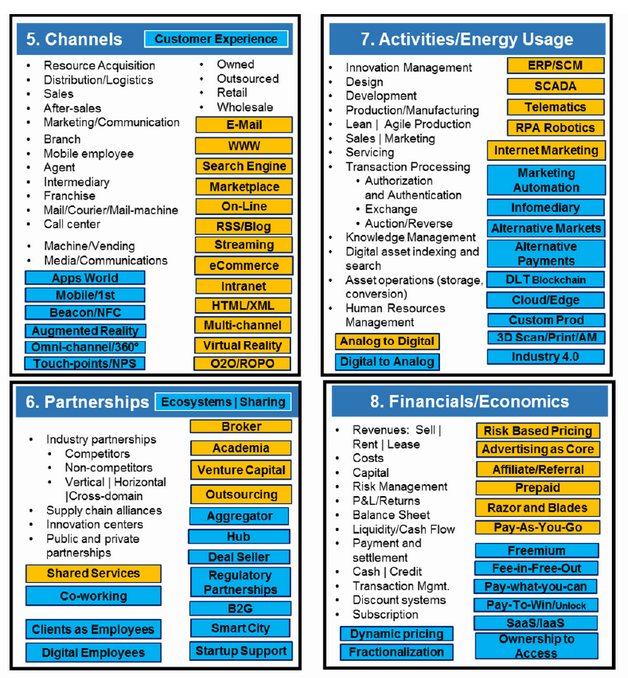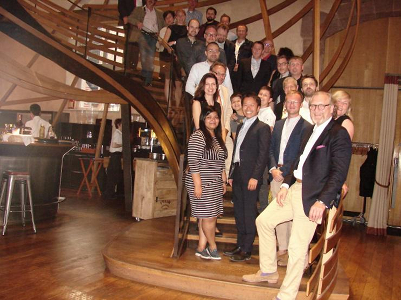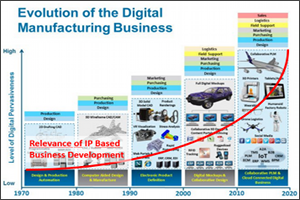MIPLM 2018-19: 6th module on IP in business development for digital business models
Within the recent years, the concept of digital transformation reached a solid and high position in strategic discussions across industries: it’s about survival of contemporary organizations. Digital transformation can be defined as the modification and adaptation of business models, resulting from the dynamic pace of technological progress and innovation that triggers changes in consumer and competitor behaviors. The driving force of the transformation are several core technologies that started gathering the critical mass of usage, enormous and unjustified investments in innovative enterprises and rapid onboarding of technological tools by consumers and businesses. Therefore, the 6th module of the MIPLM-Program addresses IP in business development for digital business models.
The discussion started with the differentiation of business models and strategy. We developed a multidimensional view on the core concepts of business models: the architecture which gives answer to the two most important questions: who is the customer and what values the customer? We used the most commonly framework which was proposed by Osterwalder and Pigneur in the form of a “business model canvas” (BMC).
The authors worked with 470 practitioners in 45 countries to gather all core elements of a business model in a single view. The resulting “canvas” contains the following components: key partners, key activities, key resources, value propositions, customer relationships, channels, customer segments, cost structures, and revenues.
The relative simplicity behind the BMC provides support for quick and efficient content documentation in the process of identifying crucial components of an organization. The BMC can be adopted to reflect the digital transformation of the business model of an organization. The information technology can be seen as an enabler of changes to the paradigms of organizations.
 Based on the case study from Hilti the concept of a BMC and the digital transformation of a business model was intensively discussed. Students mapped the drivers of the digital transformation within the BMC.
Based on the case study from Hilti the concept of a BMC and the digital transformation of a business model was intensively discussed. Students mapped the drivers of the digital transformation within the BMC.
Hilti has integrated key success factors such as high customer loyalty, a deep understanding of customer requirements, and the willingness to develop customized solutions into its IP strategy, IP design and IP management. Hilti has fully captured the digitization of the construction industry and is actively involved in shaping the transformation of planning, construction, maintenance and logistics processes.

However, Hilti does not reduce itself to adapting the process landscape in its traditional business model of device sales but has adapted the traditional business model in order to meet customer requirements in the best way possible. Having adopted a market-oriented IP culture and having adapted its IP management to its business model, the company now benefits from the protection of its business model through the use of IP. Especially the use of digital patents ensures sustainable access to key resources as well as an economically advantageous positioning in the market. The company’s patent strategy and organization were gradually adapted to the new circumstances. The patent strategy has been extended beyond the reactive approach of protecting proprietary R&D results, now including the proactive and business model-orientated creation of positions of exclusivity. The observable sustainable success of Hilti proves that the continuous adaption of IP management and IP strategy is the way forward. Here can you download the case study of Hilti.

After all participants passed the final oral examination the final dinner was organized at “Les Haras”. Set in outstanding décor, at the heart of Strasbourg on the edge of the historical “Petite France” quarter.  A mesmerizing and secret place, built in the mid-18th century along the medieval ramparts of Strasbourg, nestled in the former National Stud Farm, and classified as a historical monument since 1922.
A mesmerizing and secret place, built in the mid-18th century along the medieval ramparts of Strasbourg, nestled in the former National Stud Farm, and classified as a historical monument since 1922.
The Brasserie restaurant entertained the Masters in IP Law and Management with a modern, congenial cuisine imagined by Marc Haeberlin, 3-star chef of the Auberge de l’Ill.
The Biocluster at Les Haras was established in the former riding stables of the Haras. It accommodates innovative start-up companies. 
Supervisors from industry of the 2018/2019 MIPLM oral final examination were Dr. Stephan Wolke CEO Thyssen Krupp Intellectual Property GmbH and Hans-Jörg Schaller, head of patents and trademarks at Deutz AG.

Dr. Stephan Wolke studied physics, philosophy and macroeconomics at Bonn university and graduated in physics. He spent the first five years of his professional career at McKinsey & Company. After founding (and having sold) two own businesses Stephan Wolke was in several functions at Bayer AG as well as Danaher Corp. He joined ThyssenKrupp in 2011 and is on corporate level responsible for Intellectual Property & Services (TIS IPS) as well as head of management board of the Thyssen Krupp Intellectual Property GmbH.

Hans – Jörg Schaller studied process engineering at Stuttgart University. After employment at Mann+Hummel, Nordischer Maschinenbau Lübeck and Beru AG he joined Deutz AG in
2009 as head of patents and trademarks.
Case study presentations:
Here you can find the case study Umdasch Group Ventures about the development and protection of digital business models in the concrete building industry. Umdasch Group Ventures is the innovation hub of the Umdasch Group, which is also home to the world leading formwork company Doka. The development and protection of digital business models is based on a new sensor technology named Concremote®. It makes the building process saver and more plannable by providing real-time data about the state of the formwork. More details about Concremote® can be found in this video:
Task 1:
Digital Business Models
Please explain the market based and the resource based view. Please explain how to improve the business model on the resource perspective. Please explain the advantages of Concremote® on the resource side. Please explain how to improve the business model on the market perspective. Please explain the advantages of Concremote® on the market side. Please explain how digital technologies can improve businesses. Please explain the main features of digital business models. Please explain why the business models used for Concremote® are digital business models. Please explain the dominant business model logics and how they were implemented in the development of Concremote®. Please explain the effectiveness and efficiency increases caused by Concremote® compared to traditional building.
Here you can follow the presentation to task 1:
Presented by:
- Neha Goel, Eaton India Innovation Center, Pune, India
- Giulia Ubertone, Self-employed lawyer, Monza, Italy
- Plamena Giorgieva, EUIPO, Alicante, Spain
- Oliver Feldhaus, ITEM Industrietechnik GmbH, Germany
- Roland Bittner, Siemens AG, Erlangen, Germany
- Charles Roger, FRANCE BREVETS SAS, France
Task 2:
Digital Business Eco Systems
Please explain the four types of digital business models and their position in the „Knowledge of Your End Customer“-“Business Design“ Matrix. Please explain how to improve the business model on the resource perspective. In the ecosystem transformation manufacturing companies are developing from material suppliers to solution providers. Please explain how technologies like Concremote® help a company to become an ecosystem driver. Please explain the phases of digitization and the development of new business models and business Eco Systems for Concremote®. Please explain what the different layers of value creation in the business model are in the Concremote® case. What are the customer benefits in this B2B case? Please explain the role of digital patents and traditional patents and how they protect the customer benefits. Please explain who new digital competitors are and how the competition looks like. Please explain the business ecosystem of the digital construction site. What is digitalized and how do people and technology work together?
Here you can follow the presentation to task 2:
Presented by:
- Björn Möller, Siemens AG, Munich, Germany
- Idoia Apraiz, Galbaian, Mondragon, Spain
- Katsuya Iwazaki, Toyota Motor Corporation Ltd., Aichi, Japan
- Hendrik Promies, Siemens AG, Erlangen, Germany
- Andreas Weiland, Maschinenfabrik Rieter AG, Winterthur, Switzerland
- Isabella Ferri, Solvay SA, Bollate, Italy
- Rabia Nurgul Ozbaylanli, Turkish Patent and Trademark Office, Ankara, Turkey
Task 3:
Risk
Please explain the increase of IP related risks with the digital transformation. Please take into account the new digital business models and the role of digital patents. Please explain the increase of IP related risks due to new competitors. Please take into account the effect of digital business Eco Systems and how the role of business sectors changes in the digitalization. Please explain the role of standard essential patents (SEP) and why the IP-Risk is growing especially through these patents. Please explain the role of standard essential patents (SEP) in the Concremote® case, when using 5G to transmit data between the sensors and the software. To find licensing conditions for standard essential patents (SEPs) the FRAND concept was introduced and licenses should comply with the FRAND conditions. Please explain what FRAND stands for. Please explain the approaches and problems to find a FRAND compliant license rate.
Here you can follow the presentation to task 3:
Presented by:
- Michael Kirklies, KIPAT Patentanwälte, Neu-Ulm, Germany
- Christiane Marti, Novartis Pharma AG, Basel, Switzerland
- Vincent Chevroton, Faurecia Innenraum Systeme GmbH, Hagenbach, Germany
- James Eilertsen, Heptagon OY, Rueschlikon/Zurich, Switzerland
- Frederic Sahores, STMicroelectronics SA, France
- Kamran Houshang Pour Islam, IPI, Bern, Switzerland



